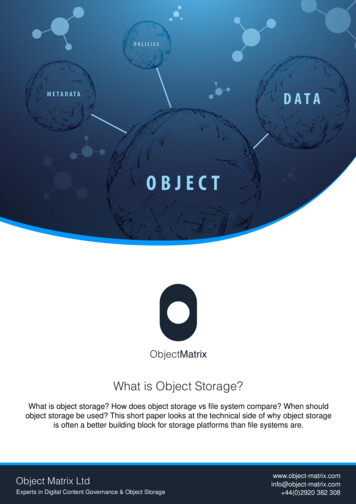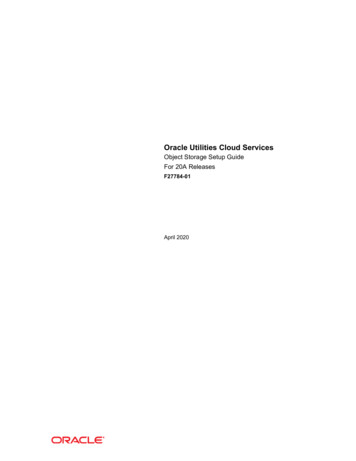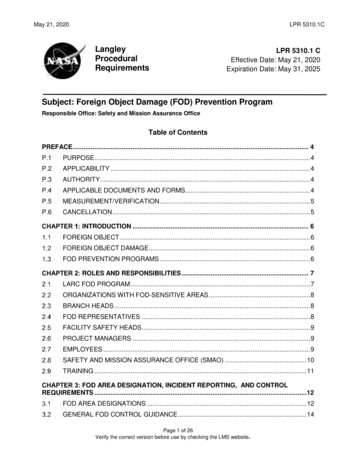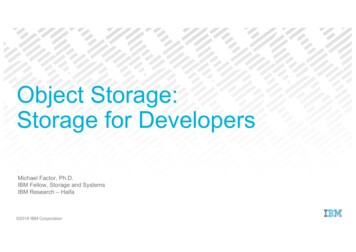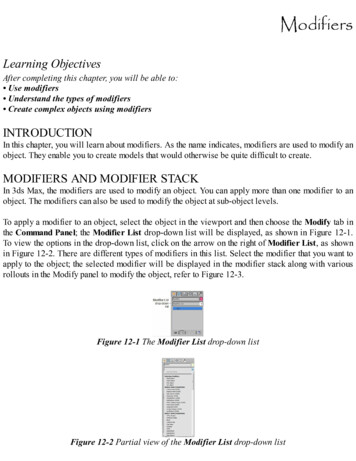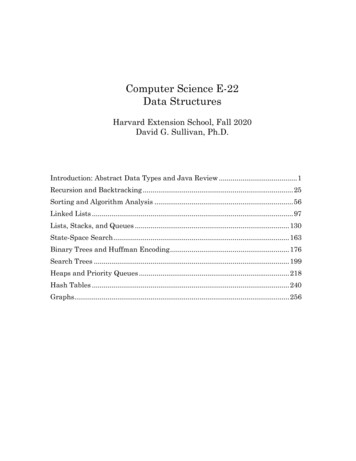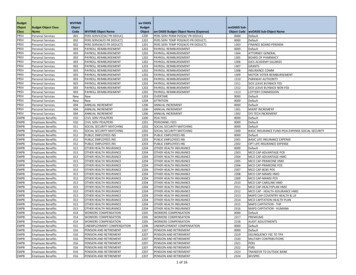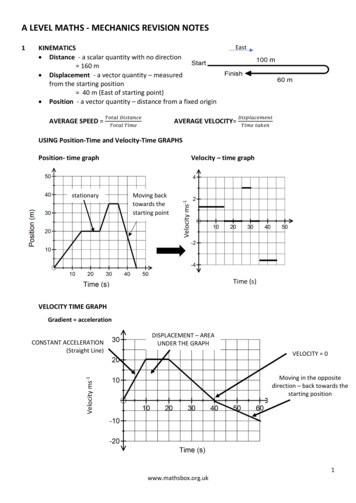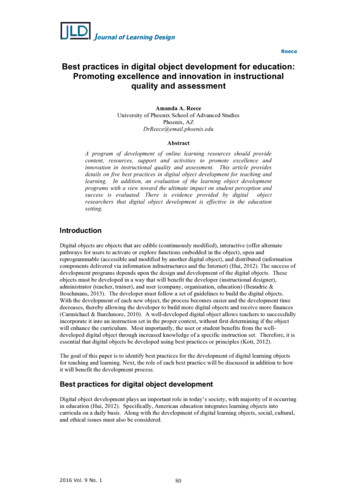
Transcription
Journal of Learning DesignReeceBest practices in digital object development for education:Promoting excellence and innovation in instructionalquality and assessmentAmanda A. ReeceUniversity of Phoenix School of Advanced StudiesPhoenix, AZDrReece@email.phoenix.eduAbstractA program of development of online learning resources should providecontent, resources, support and activities to promote excellence andinnovation in instructional quality and assessment. This article providesdetails on five best practices in digital object development for teaching andlearning. In addition, an evaluation of the learning object developmentprograms with a view toward the ultimate impact on student perception andsuccess is evaluated. There is evidence provided by digital objectresearchers that digital object development is effective in the educationsetting.IntroductionDigital objects are objects that are edible (continuously modified), interactive (offer alternatepathways for users to activate or explore functions embedded in the object), open andreprogrammable (accessible and modified by another digital object), and distributed (informationcomponents delivered via information infrastructures and the Internet) (Hui, 2012). The success ofdevelopment programs depends upon the design and development of the digital objects. Theseobjects must be developed in a way that will benefit the developer (instructional designer),administrator (teacher, trainer), and user (company, organisation, education) (Beaudrie &Boschmans, 2013). The developer must follow a set of guidelines to build the digital objects.With the development of each new object, the process becomes easier and the development timedecreases, thereby allowing the developer to build more digital objects and receive more finances(Carmichael & Burchmore, 2010). A well-developed digital object allows teachers to successfullyincorporate it into an instruction set in the proper context, without first determining if the objectwill enhance the curriculum. Most importantly, the user or student benefits from the welldeveloped digital object through increased knowledge of a specific instruction set. Therefore, it isessential that digital objects be developed using best practices or principles (Kott, 2012).The goal of this paper is to identify best practices for the development of digital learning objectsfor teaching and learning. Next, the role of each best practice will be discussed in addition to howit will benefit the development process.Best practices for digital object developmentDigital object development plays an important role in today’s society, with majority of it occurringin education (Hui, 2012). Specifically, American education integrates learning objects intocurricula on a daily basis. Along with the development of digital learning objects, social, cultural,and ethical issues must also be considered.2016 Vol. 9 No. 180
Journal of Learning DesignReeceThe majority of digital learning objects for education are developed within the United States. Forexample, because of trade restrictions, digital learning objects developed in certain countriescannot be used in others (Murray-Lasso, 1990). For example, an American software companycould not comply with the Mexican government’s restrictions. As a result, there is no means ofinstalling US-developed software in Mexico.Language is an important constraint on educational software. Digital learning objects must bedeveloped in a variety of languages, to address the diverse populations of education. If teachersand students do not understand the learning object, then it is of no value to them. In addition, theinstructional designer must consider cultures preferring writing over speaking and vice versa(Dunbar, 1991). There may be students who prefer learning objects with audio and some who donot.Another aspect of digital object development to consider is curricula. For example, differentcountries and cultures emphasise different content areas within mathematics. One culture mayfocus on theory, while another emphasises application (Dunbar, 1991).Digital objects developers must also consider the pedagogical approach. Learning styles used inonline exercises may differ across countries or cultures (Murray-Lasso, 1990). For example, onemay teach conceptual and intuitive aspects of mathematics, while another may teach rote-fashionmathematics. Therefore, a combination of learning styles (pedagogical approaches) isrecommended when developing the learning object (University of Illinois, 2015).Social, cultural, and ethical issues are very important aspects to consider in the development ofdigital objects in American education. While these are specific to any culture, there are generalbest practices used in the development of all digital objects, regardless of cultural, social, or ethicalissues.Although there are no specific guidelines for instructional designers on planning, designing, anddeveloping digital objects, several authors in the literature have developed some to aid in thedevelopment process. These guidelines (best practices) suggest how to provide adequate butgeneral content, determine the level of detail of each digital object and format and store them forfuture use (Kott, 2012). Several authors agree on five best practices for developing digital objects:granularity, formatting standards, stand-alone capabilities, composition and stylistic approach, andcreation of metadata and tags (Kott, 2012).Granularity of Digital ObjectsThe details level or granularity of a digital object is a critical factor that determines its reusability.Ideally, a digital learning object should include no more than four related ideas (University ofIllinois, 2015). The instructional designer must determine how many topics are stand-alone orreusable in a different context. A digital object consisting of more than one idea should have onemain idea. Other ideas should be derived from or dependent upon the main one. If the contentdepth of the digital object is ascertained by the idea or concept, then it is not subject to theopinions of an individual’s choice of instructions or methodologies (Matthews, Hin & Choo,2014).Currently there are no standards for verifying the details depth of digital objects. However, Iversonsuggests it remain small for potential reuse (2013). Hui (2012) adds the need to foster acompetency-based learning approach that is also adaptive in nature. In addition, Graham (2013)suggests that a digital object’s content level should be based upon a meaningful separation oflearning that can be completed by a student in an ongoing effort; allowing learning to take place inone sitting.2016 Vol. 9 No. 181
Journal of Learning DesignReeceFlexibility is a major issue that depends upon the details of the digital object. If it is small, then itcan be used in multiple contexts. For example, one type of learning may require concepts to bepresented first, followed by problems. Conversely, another application may present the problemsfirst, then concepts (University of Illinois, 2015).There are several factors aiding instructional designers in determining the content depth of digitalobjects, including the instructional formatting used to create the content and delivery system.Specific usability requirements may influence decisions regarding content (Hui, 2012). There aremore generic objects developed, where the primary goal is sharing and reusability. This may resultin profits being a primary concern. As a result, minimal digital object content variations supportmaximum reuse 2012).Formatting standards for Digital ObjectsProper formatting of digital objects ensures quality, uniform, and understandable pedagogicalstrategy. Good formatting techniques ensures digital objects are frequently used, as instructionaldesigners easily accept these for creation of other objects.Digital objects should follow a standard format. Several instructional design books explain how totailor what is being taught to instructional strategies. This format includes a broad, comprehensiveview of the task or activity, identifying the steps of the activity, overseeing the users (students) asthey show mastery of each step, demonstrating how to integrate all steps of the activity, andproviding systematic practice to the application.The technical specifications address interoperability and the physical structure of the digital objectto easily manipulate elements (Kott, 2012). Objects should be developed for all operating systemsand delivery media. XML is the ideal language to use (NISO, 2007). It is a metalanguage writtenin SGML, which allows one to design a markup language for easy document exchange across theInternet. Presentation and content, and structure separation are the foundational logic behindXML, which allow the flexibility required to control and put digital objects into action (Oorschot,2012).Issues concerning digital object formatting must be solved before being used in schoolenvironments. These environments are quite new to using digital objects in the curriculum.Formatting issues, such as the operating systems or instructional strategies that enhance learningtypes must be considered and structured correctly, to lessen frustration for teachers and students.Selecting instructional strategies have been shown to enhance different learning styles.Stand-alone capabilities of Digital ObjectsAll digital objects should be independent of other objects or activities in order to properly functionin a curriculum. Objects must have organised knowledge elements and allow guidance andfeedback for students (Wiley, 2001). In order to contain the aforementioned factors, digital objectsmust be created using generic information. Instructional context comes from assembling objectsinto an instructional sequence. Longmire (2000) suggested the following guidelines for designingstand-alone objects. First, use correct content and language for all appropriate audiences. Moreaudience-specific information can be added, if desired, once the instructional designer assemblesthe object into the instructional context (Longmire, 2000). Next, the object content must be similarin nature to the content of a typical lesson. The objective is to create instruction and not merelyinformation (Instructional Designs, 2013). Then, each digital object must not cause confusionbetween other unrelated topics (Iverson, 2013). Finally, individual objectives must be satisfied bythe development of content (Longmire, 2000).2016 Vol. 9 No. 182
Journal of Learning DesignReecePrimary and secondary school students are a prime reason why digital objects are developed to bestand-alone. It is best for students to learn content, one objective at a time, since their minds havenot developed enough to retain large chunks of information at one time. Stand-alone digitalobjects are developed in a generalised manner, so that teachers can reuse the object in differentlearning contexts. Students or any learner retains information as a result of practice or, for thispurpose, reusing digital objects.Composition and stylistic approach of Digital ObjectsComposition and style play a vital role in whether a digital object will hold the interest of the user.Once the composition is discovered, the style of the object can be designed. The compositionincludes the elements of the object, whereas the style is the appearance.The composition of a digital object consists of elements such as text, image, multimedia, video,glossary, and assessment. A digital object should consist of a combination of multiple elements, toreinforce the communicated concept. It also provides more than one way to foster understandingof the represented idea(s). This facilitates learning based on learners’ characteristics and choices(Giaretta, 2011).The presentation of digital objects is based upon style and appearance. Specifications aredetermined by instructional designers/developers image layout, font, colour, and text (Beaudrie &Boschmans, 2013). The combination of these structural elements should be consistent throughoutthe digital object. XML is known for separating appearance, content, and structure. As a result,subject matter experts (SME) can exclude the stylistic approaches. Since XML is flexible,different content can use the same style sheets without additional development (Wiley, 2001).Each style sheet can be edited without affecting or making changes to the other. An ideal situationwould be to develop user-controlled stylistic environments and several interfaces. The mostsuitable forms of exploring and interacting with the knowledge and interacting is then chosen bythe user for maximum effectiveness and benefit.Style and composition are two factors of digital object development that will grasp the attention ofstudents. The more colourful and exciting the object appears to be, the longer a student will wantto work on the activity. Although all internal features and technical aspects of developing a digitalobject are vital, style and composition become equally important in the development stage, tomake it an enjoyable learning experience for students.Metadata and tags for Digital ObjectsA good digital object has and is associated with metadata. All good objects have administrativeand descriptive metadata (Kott, 2012). Administrative metadata provides information thatmanages a resource, such as who can access it or technical information such as file type (Graham,2013). Descriptive metadata describes a resource for purposes such as identification anddiscovery. It includes elements such as title, author, and keywords (2013). Metadata must providedescriptive information about the object. It is considered to be structured data describing thecontent. Metadata file creation is known as tagging. Once created, the metadata file is placedwithin a repository or specific storage (Longmire, 2000).Metadata is valuable for the discovery of existing content in a content repository. Instructionaldesigners use metadata to search for existing learning objects. In addition, they write metadata fornewly-created objects. Users can understand what a learning object is without seeing it. This isdone by completing fields in the metadata file. Eventually, high-quality metadata may be requiredto assemble objects used by learning management systems to adapt the material to the needs of thelearner (Coyle, 2010). Below is a summarised list of guidelines related to the use anddevelopment of metadata:2016 Vol. 9 No. 183
Journal of Learning DesignReece If an instructional designer creates his/her own metadata scheme for internal use, developa set of tags that are not very big. Tagging and cataloguing is the greatest expense anddelay in developing objects (Coyle, 2010). Object hierarchy should be represented using a language such as XML. As a result, atagging system can be used to structure online course object components. (Iverson,2013). Constantly evolving trainings should not use metadata schemes (also called schema). Bythe time the metadata schema are built and tagged, they may be obsolete (Schwartz,2000). Create content objects as interactions stored in databases, and representations ofinstruction (Iverson, 2013). Create the metadata to describe the learning object. The metadata should describe theobject’s teaching objectives, use requirements, and content (2013). Best practices in digital object development demonstrate how detailed developmentprocess is. Many organizations such as universities use these strategies to create effectivelearning activities for students.ConclusionDigital objects used in settings are appropriately defined as any digital resource that can be reusedto provide learning support (Wiley, 2000). Developing these objects require careful considerationof specific instruction as well as curricula. Several best practices for the development of theseobjects include granularity, formatting standards, stand-alone capabilities, composition andstylistic approach, and metadata creation (Giaretta, 2011; Kott, 2012). Granularity addresses theamount of detail within the object. It should neither be too vague or specific to function as alearning activity. Formatting standards deal with the object’s compatibility for all operatingsystems. Stand-alone capabilities deal with the inclusion of all development features needed forthe object to be an independent learning activity. Composition and stylistic approach addresses thelearning object’s appearance to the student. Metadata creation addresses the description of thedigital object content. This information should provide the user an overview of what the digitalobject is about (Giaretta, 2011; Kott, 2012). These practices combine to form a digital objectcomposed of all necessary components – content, resources, support and activities.As more educational organisations develop and use digital learning activities, the more commontechnology integration and online learning will become in education. This technology exposurewill increase student knowledge in several different subject areas. As a result of using bestpractices, digital objects become measurable, notably successful or effective with the intendedaudience, and, in some cases, replicable. Formatting, composition and stylistic approach, andstand-alone capabilities are clear practices that produce solid goals, and the progress towards themcan be measured for creditability and validity (Community Tool Box, 2015). These guidelineshave been evaluated and applied to digital object development by many instructional designers.The methods are more successful than other similar practices because they not only yield goodresults but also make progress towards achieving good digital object development andmaintenance processes (Graham, 2012). In addition, these practices have been well documented, toreproduce operative digital objects in other settings.2016 Vol. 9 No. 184
Journal of Learning DesignReeceReferencesBeaudrie, B., & Boschmans, B. (2013). Attitudes towards technology use in mathematics amongPre-Service K-6 teachers. In R. McBride & M. Searson (Eds.), Proceedings of Society forInformation Technology & Teacher Education International Conference 2013 (pp. 4361-4366).Chesapeake, VA: AACE.Carmichael, P., & Burchmore, H. (2010). Social software and academic practice: Postgraduatestudents as co-designers of Web 2.0 tools. The Internet and Higher Education, 14(3), 233-241.Retrieved from 1096751610000497Coyle, K. (2010). Understanding the Semantic Web: Bibliographic Data and Metadata. ALALibrary Technology Reports. Retrieved from data-and-metadataCommunity Tool Box. (2015). Section 6. Promoting the adoption and use of best practices.Retrieved from actices/mainDunbar, R. (1991). Adapting distance education for Indonesians: Problems with learnerheteronomy and a strong oral tradition. Distance Education, 12(2), 163-174.Giaretta, D. (2011). Advanced digital preservation. New York: Springer Science & BusinessMedia.Graham, R. (2013). The perception of digital objects and their impact on development.Psychoanalytic Psychotherapy, 27(4), 269-279.Hui, Y. (2012). What is digital object? Metaphilosophy, 43(4), 380-395.Instructional Designs. (2013). Learning objects. Retrieved fromhttp://www.instructionaldesign.org/learning objects.htmlIverson, K. (2013). Sustainable Learning through Reusable Learning Objects: Reduce, Reuse,Roosevelt University Training. (2013). Recycle. Retrieved use-recycleKott, K. (2012). Digital Repository Best practices for cultural heritage organizations. ComputerHistory Museum. Retrieved from loads/2012/09/Best Practices Report 2012-02.pdfLearning Technology Standards Committee. (2000). Learning objects metadata. Retrieved fromhttp://ieeeltsc.orgLongmire, W. (2000). Content and context: Designing and developing learning objects. LearningWithout Limits, Vol. 3. Informania.Matthews, R., Hin, H.S. & Choo, K.A. (2014). Learning object to enhance introductoryprogramming understanding: Does the size really matter? The Turkish Online Journal ofEducational Technology 13 (1), 174-183. Retrieved fMowat, J. (2007). The instructional design of learning objects. Learning Solutions Magazine.Retrieved from Lasso, M. A. (1990). Cultural and social constraints on portability. Journal of Research onComputing in Education, 23(2), 252-269.University of Illinois (2015). Learning styles and the online environment. Retrieved 016 Vol. 9 No. 185
Journal of Learning DesignReeceWiley, D. (2000). The instructional use of learning objects. Open Publication License. Retrievedfrom http://www.reusability.org/read/chaptersWiley, D. A. (2001). Connecting learning objects to instructional design theory: A definition ametaphor, and a taxonomy. In D. A. Wiley (Ed.), The instructional use of learning objects.Bloomington, IN: Association for Educational Communications and Technology. Retrievedfrom right 2016 Amanda A. Reece2016 Vol. 9 No. 186
developed digital object through increased knowledge of a specific instruction set. Therefore, it is essential that digital objects be developed using best practices or principles (Kott, 2012). The goal of this paper is to identify best practices for the development of digital learning objects for teaching and learning.
